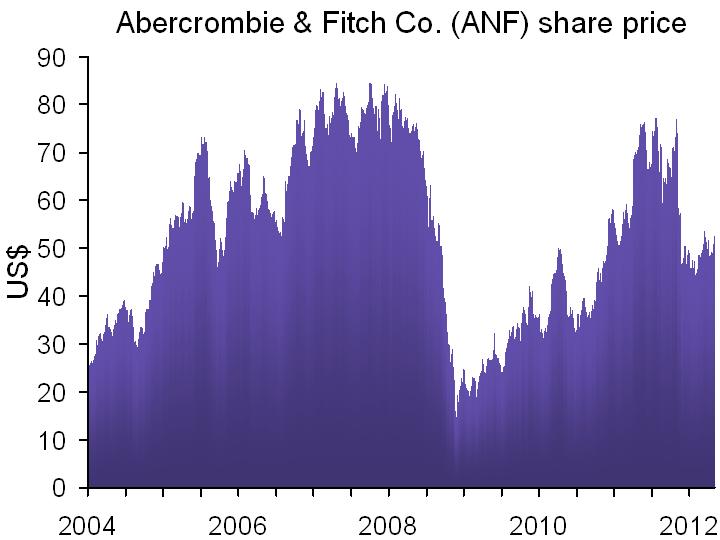 After weak Christmas trading, Tesco issued a profit warning – its first in 20 years. Following this, their shares fell in value by some £5bn, but this was met with an announcement of the creation of 20,000 jobs in the coming years, as part of a project to train staff, improve existing stores and open new ones. Yet, Tesco has reported another quarter of falling sales.
After weak Christmas trading, Tesco issued a profit warning – its first in 20 years. Following this, their shares fell in value by some £5bn, but this was met with an announcement of the creation of 20,000 jobs in the coming years, as part of a project to train staff, improve existing stores and open new ones. Yet, Tesco has reported another quarter of falling sales.
Trading times have been challenging and the fact that the UK’s biggest supermarket is struggling is only further evidence to support this. In the 13 weeks to the 26th May 2012, Tesco reported a decline in like-for-like sales of 1.5%. Although much of the £1bn investment in Tesco is yet to be spent, the fact that sales have fallen for a full year must be of concern, not only to its Chief Executive, but also to analysts considering the economic future for the UK.
Consumer confidence remains low and together with tight budgets, shoppers are continuing to be very cautious of any unnecessary spending. Part of Tesco’s recent drive to drum up sales has been better customer service and a continuing promotion war with the other supermarkets. This particular sector is highly competitive and money-off coupons and other such promotions plays a huge part in the competitive process. Whilst low prices are obviously crucial, this is one sector where non-price competition can be just as important.
Although Tesco sales in the UK have been nothing to shout about – the Chief Executive said their sales performance was ‘steady’ – its total global sales did increase by 2.2%. The Chief Executive, Mr Clarke said:
‘Internationally, like-for-like sales growth proved resilient, despite slowing economic growth in China…Against the backdrop of continued uncertainty in the eurozone, it is pleasing to see that our businesses have largely sustained their performance.’
A boost for UK sales did come with the Jubilee weekend and with the Olympics just round the corner, Tesco will be hoping for a stronger end to the year than their beginning. The following articles consider Tesco’s sales and the relative performance of the rest of the sector.
Tesco’s quarterly sales hit by ‘challenging’ trading BBC News (11/6/12)
Tesco UK arm notches up one year of falling sales Guardian, Zoe Wood (11/6/12)
Tesco upbeat despite new sales dip Independent, Peter Cripps (11/6/12)
Tesco sales seen lower in first quarter Reuters, James Davey(11/6/12)
The Week Ahead: Tesco set to admit it is losing ground to rivals Independent, Toby Green (11/6/12)
Tesco’s performance in the UK forecast to slip again Telegraph, Harry Wallop (10/6/12)
Tesco: What the analysts say Retail Week, Alex Lawson (11/6/12)
Supermarkets issue trading updates The Press Association (9/6/12)
The Week Ahead: Supermarkets prepare to give City food for thought Scotsman, Martin Flanagan (11/6/12)
Asda’s sales growth accelerates Reuters, James Davey (17/5/12)
Asda sales increase helped by Tesco Telegraph, Harry Wallop (18/5/12)
Tesco v. Sainsbury’s in trading update battle Manchester Evening News (11/6/12)
Sainsbury’s out-trades Tesco on UK food sales Independent, James Thompson (10/6/12)
Questions
- Using some examples, explain what is meant by non-price competition.
- Why has Tesco been losing ground to its competitors?
- Given the products that Tesco sells (largely necessities), why have sales been falling, despite household’s tight budgets?
- Into which market structure would you place the supermarket sector? Explain your answer by considering each of the assumptions behind the market structure you choose.
- Why have Tesco’s rivals been gaining ground on Tesco?
- How might this latest sales data affect Tesco’s share prices?
- Based on what the analysts are saying about the food sector, can we deduce anything about the future of the UK economy in the coming months?
 The trendy US fashion retailer Abercrombie & Fitch entered the UK in 2007 with the opening of a flagship store close to Savile Row in London. Located in the upmarket Mayfair area of London, Savile Row is famous for its traditional men’s tailors.
The trendy US fashion retailer Abercrombie & Fitch entered the UK in 2007 with the opening of a flagship store close to Savile Row in London. Located in the upmarket Mayfair area of London, Savile Row is famous for its traditional men’s tailors.
Recently Abercrombie & Fitch decided to go one step further by opening a childrenswear store directly on Savile Row. This move upset the local retailers and was met with protests.
This was just the latest in a history of controversy surrounding Abercrombie & Fitch which has included a product boycott and a lawsuit concerning employment issues. Should all this bad publicity be a concern for the company?
We expect tastes to be one of the key determinants of demand. If taste for a company’s product declines, its demand curve shifts to the left. This means it can sell less at any given price and consequently will have a knock-on effect on profits. Somewhat surprisingly, therefore, the PR expert, Mark Borkowski, quoted in the Guardian article above, suggests that all this adverse publicity may have in fact helped the company because:
“…the focus is on the brand. They’ve got a very keen identity of who they are, what they want, who they want to consume their products, and they’ve stuck to it.”
It is also clear that the company is very aware of the importance of protecting its brand – even going as far as paying television actors NOT to wear their clothes! Abercrombie & Fitch has also been reluctant to cut its prices during the current recession, perhaps because of a fear of harming its brand.
Abercrombie & Fitch with its ‘crappy clothes’ threatens staid Savile Row Observer, Euan Ferguson (11/03/12)
Savile Row cannot live in the past Guardian, Charlie Porter (24/04/12)
Sorry chaps, Abercrombie & Fitch simply doesn’t fit Savile Row Guardian, Gustav Temple (24/04/12)
Savile unrest … the tailors who want to stop Abercrombie & Fitch London Evening Standard, Josh Sims (27/04/12)
Questions
- What are the distinctive features of the Abercrombie & Fitch brand?
- What are the key features of competition in this industry?
- Why might Abercrombie & Fitch be keen to open up a store on Savile Row?
- Why might the local tailors object to Abercrombie & Fitch opening a store nearby?
- Why do you think negative publicity appears to have little effect on Abercrombie & Fitch?
- Why do you think television coverage could harm the Abercrombie & Fitch brand?
 Advertising is a costly venture, but for firms in a highly competitive market it can be essential for success. During the recession, many firms had to make a variety of cut backs and reduced advertising for many was one of the key areas to go.
Advertising is a costly venture, but for firms in a highly competitive market it can be essential for success. During the recession, many firms had to make a variety of cut backs and reduced advertising for many was one of the key areas to go.
However, one of the leading advertising companies – WPP – has posted significant profits this year, which are up by some 18.5%, reaching £1.008bn. According to Sir Martin Sorrell, a key factor in this success is that many firms, whilst not looking to increase their market share, have felt the need to continue advertising, simply to maintain their existing market share. This has become especially important in growing markets, as competition has become more and more intense.
This new is not only good for the company in question, but also for the UK economy, as the firm has said that it will be moving its headquarters back from Ireland to the UK. This is assuming that legislation is passed concerning the taxation of profits earned abroad. If this relocation does go ahead, it could mean the creation of many more jobs in the UK and a boost to tax revenues, both of which are crucial for the UK economy. As Sir Martin Sorrell said:
‘I am delighted to say that the last remaining issues I think have been removed subject to legislation being introduced in Parliament. We will be coming back subject to shareholder approval’.
WPP believes growth throughout 2012 will be high, due to events such as the Olympics and the US Presidential elections, together with its strength in emerging economies. At the moment, this all looks like good new for the UK and oh how it’s needed!
WPP profit up ahead of 2012 Olympics boost Reuters (1/3/12)
WPP’s Martin Sorrell says he is likely to move HQ back to London Guardian, Mark Sweney (1/3/12)
Olympics, Election to boost WPP Wall Street Journal, Kathy Gordon (1/3/12)
WPP breaks £1bn profit barrier Guardian, Mark Sweney (1/3/12)
WPP boosts dividend after strong year Financial Times, Tim Bradshaw and Mark Wembridge (1/3/12)
WPP profits reach record in 2011 BBC News (1/3/12)
Questions
- What is market share and how can it be calculated?.
- What is the purpose of advertising. Using a supply and demand diagram, illustrate the effect the advertising should have. Think about the position and the shape of the curves.
- Why is advertising an area that did see cut backs throughout the recession?
- Do you think that advertising is more important for firms in growing markets? Explain your answer.
- Why did WPP relocate to Ireland and what may bring it back to the UK?
- How have WPP’s dividend payments been affected by this latest profit information?
- During a recession, competition tends to become more intense. Why is this and what role does advertising play?
 Every firm has been hit by the recession and for most, it’s been bad news. However, the latest firm to file for bankruptcy is an interesting case, as the causes extend well beyond a weak economy. The company in question? Eastman Kodak. Renowned for inventing the hand-held camera and being the market leader, selling 90% of photographic film and 85% of all cameras in the USA in 1976, the company has since seen a large change in its fortunes.
Every firm has been hit by the recession and for most, it’s been bad news. However, the latest firm to file for bankruptcy is an interesting case, as the causes extend well beyond a weak economy. The company in question? Eastman Kodak. Renowned for inventing the hand-held camera and being the market leader, selling 90% of photographic film and 85% of all cameras in the USA in 1976, the company has since seen a large change in its fortunes.
Massive competition has emerged from all over the globe and the company has seemed to lag behind the digital revolution. Arguably, unwilling to take risks and making some strategic errors, Kodak saw its stock tumble from $94 in 1997 to under $1 per share in 2012. Since 2004, Kodak has only seen one profitable year. With massive competitors in the world of digital photography, the market has become a highly competitive one. As Rupert Goodwins, the editor of technology website ZDNet said:Kodak made all its money from selling film, then the digital camera came along and now no-one’s buying film. It’s not like they didn’t see it coming. Kodak hesitated because they didn’t want to eviscerate their business.
By filing for bankruptcy, Kodak is protected and its operations will continue for the time being, perhaps giving the company time to have a rethink and a reorganization. Eastman Kodak has previously tried to take a new direction and has been moving away from film and towards its printer, software and packing businesses. The problem is that these markets already have some very strong competitors: Hewlett Packard, Canon and Epson. It’s a difficult job to break into this market and gain market share.
The future of the company is very much in the balance and as reorganization of its operations looks inevitable, so does a loss of jobs. Thank goodness it only employs some 19,000 workers and not the 145,000 it did back in its day. Bankruptcy will certainly keep the creditors at bay for the time being, but it is by no means a long term solution to the company’s ailing profits. The following articles consider this ‘Kodak moment’.
Eastman Kodak files for bankruptcy protection BBC News (19/1/12)
Eastman Kodak files for bankruptcy The Christian Science Monitor, Ben Dobbin (19/1/12)
Kodak: From Brownie and roll film to digital disaster BBC News, James Cowling (19/1/12)
Kodak files for bankruptcy CNN Money, Aaron Smith and Hibah Yousuf (19/1/12)
Photography pioneer Kodak files for bankruptcy Reuters, Jonathan Stempel (19/1/12)
Kodak: 30 fascinating facts The Telegraph, Matthew Sparkes (19/1/12)
Kodak: why the moment has oassed Guardian, Simon Waldman (19/1/12)
Questions
- Using the product life cycle, explain where Kodak currently lies.
- To what extent are Kodak’s current problems related to the obsolescence of their products and not the recession?
- What strategic errors have Kodak made?
- What has caused Kodak’s collapse in share prices and profitability?
- Why is Eastman Kodak finding it difficult to gain market share in other markets, such as printing?
- What options are open to Kodak for the future if it is to become profitable once more?
When people shop in supermarkets they often look for what’s on special offer. After all, everyone likes a bargain. About 35–37% of supermarket items are on special offer at any one time and around 50% of the money spent by customers is on such items.
But things aren’t always as they seem. Supermarkets use clever marketing to persuade people that they’re getting a good deal, while sometimes it’s nothing of the sort. Examples include putting up prices for a while and then reducing them again saying “huge reduction”; or promoting an offer of, say, “three for £2”, when you could buy an individual item for 60p; or using the word “now” £2.50 to imply that the previous price was higher, when in fact it wasn’t; or selling a double-sized “value pack” for more than double the price of the regular size. These tricks are commonplace in supermarkets.
Sometimes the wary consumer will be able to find out which offers are genuine, but it’s not always that easy. And even if you do buy something at a genuine discount, is it something you really want? Or have you been persuaded to buy it simply because it’s on offer? Supermarkets study consumers’ psychology. They find clever ways of promoting products to make us feel that we have done well in getting a bargain.
The following programme in the BBC’s Panorama series looks at the big four supermarkets in the UK – Tesco, Asda, Sainsbury’s and Morrisons – which between then have 68% of supermarket sales. It gives examples of some of the not so special offers and how consumers are being hoodwinked.
Webcast
 Revealed: The truth about supermarket ‘bargains’ BBC Panorama (clip), Sophie Raworth (5/12/11)
Revealed: The truth about supermarket ‘bargains’ BBC Panorama (clip), Sophie Raworth (5/12/11)
 The Truth About Supermarket Price Wars BBC Panorama (full programme), Sophie Raworth (5/12/11)
The Truth About Supermarket Price Wars BBC Panorama (full programme), Sophie Raworth (5/12/11)
Articles
What you need to know about the supermarket price wars Totally Money (7/12/11)
Supermarkets accused of misleading consumers The Telegraph, Nick Collins (5/12/11)
Supermarket price war: Can they all be cheapest? BBC News, Anthony Reuben (9/12/11)
Are Our Retailers Criminals? International Supermarket News, Laura Elliott (6/12/11)
Supermarket deals “not what they seem” warns expert Retail Gazette, Gemma Taylor (6/12/11)
Questions
- What types of misleading offers are identified in the Panorama report?
- For what reasons are consumers “taken in” by such offers? Does this imply that consumers are irrational?
- Does intense oligopolistic competition between the big four supermarkets lead to lower prices?
- How is it possible for two supermarkets to claim that they are cheaper than the other? How would you decide which supermarket was generally cheaper?
- Why might it be difficult for an independent agency to do a comparison of prices of different supermarket chains?
 After weak Christmas trading, Tesco issued a profit warning – its first in 20 years. Following this, their shares fell in value by some £5bn, but this was met with an announcement of the creation of 20,000 jobs in the coming years, as part of a project to train staff, improve existing stores and open new ones. Yet, Tesco has reported another quarter of falling sales.
After weak Christmas trading, Tesco issued a profit warning – its first in 20 years. Following this, their shares fell in value by some £5bn, but this was met with an announcement of the creation of 20,000 jobs in the coming years, as part of a project to train staff, improve existing stores and open new ones. Yet, Tesco has reported another quarter of falling sales.


